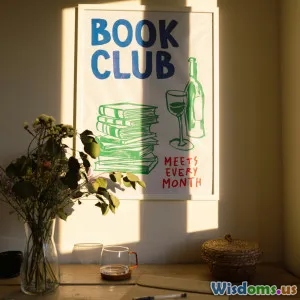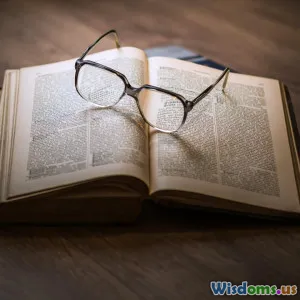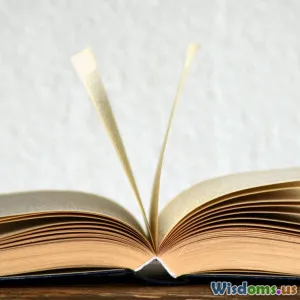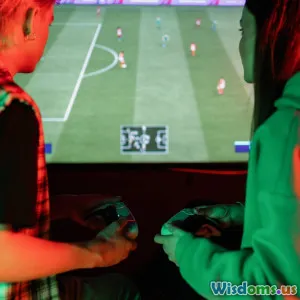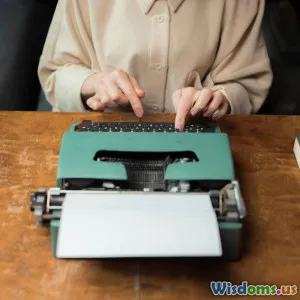
The Intersection of Literature and Technology
7 min read Explore how technology reshapes literature, from digital publishing to AI-authored stories, blending tradition with innovation. (0 Reviews)
The Intersection of Literature and Technology
Introduction
Imagine a world where books are no longer just ink on paper but dynamic, interactive experiences crafted by sophisticated algorithms and immersive technology. This is not a distant future; it’s the present reality. The intersection of literature and technology represents a radical transformation in how stories are told, shared, and consumed. While literature is one of humanity’s oldest art forms, technology continuously redefines its boundaries and possibilities.
This article delves deep into this fascinating crossroads—how digital tools, artificial intelligence, and new media are revolutionizing literature, challenging traditional norms, and expanding the horizons of readership and authorship.
The Digital Publishing Revolution
For centuries, the publishing world revolved around physical books distributed through bookstores and libraries. The advent of digital technology changed this drastically.
The Rise of E-Books and Audiobooks
E-books have democratized access to literature worldwide. By 2023, the global e-book market reached a valuation of approximately $35 billion, highlighting a growing demand for digital content. Devices like Amazon’s Kindle, Apple Books, and Google Play Books allow readers to carry thousands of works in one lightweight device.
Audiobooks have similarly reshaped literature consumption. Platforms like Audible reported over 425 million audiobooks sold in recent years, catering to increasingly busy lifestyles and embracing auditory learning styles. The convenience and accessibility help reach audiences that traditional print sometimes does not.
Self-Publishing Platforms Expand Author Opportunities
Traditional publishing could often be a gatekept domain. Today, self-publishing platforms such as Wattpad, Smashwords, and Amazon Kindle Direct Publishing empower aspiring authors globally. Writers have direct control over their content, marketing, and profits. For instance, Andy Weir’s "The Martian" began as self-published work before being picked up by a major publisher and adapted into a blockbuster film.
This shift also fosters diverse voices, helping underrepresented groups share narratives that might otherwise remain unheard.
Artificial Intelligence and Creative Writing
Artificial intelligence is no longer just a tool for analysis but a creative partner in the literary space.
AI as Collaborative Author
Language models like GPT-4, developed by OpenAI, can generate fluent prose, poetry, and complex narratives. Writers leverage these tools to overcome writer’s block, brainstorm ideas, or even co-author entire stories.
Several novels have been produced with AI assistance. For example, the short novel "1 the Road" was generated through neural networks processing over 20,000 pages of text and photographs, demonstrating AI’s capability to contribute to experimental storytelling.
Ethical and Artistic Debates
While AI can boost productivity, critics argue about the erosion of human originality and creativity. What does it mean when a machine can simulate empathy in a story? Renowned author Margaret Atwood expressed caution: “Technology can assist the telling, but the soul of literature belongs to the human experience.” The ongoing debate challenges the literary world to find a balance between automation and authentic voice.
Immersive and Interactive Storytelling
Technology has enabled new storytelling formats beyond the traditional linear narrative.
Hypertext and Nonlinear Narratives
Digital literature can be nonlinear, offering readers choices that alter the story’s outcome. Early experiments like Michael Joyce’s "Afternoon, a story" used hypertext to create a web of interlinked narratives.
Today, interactive fiction platforms like Twine empower anyone to craft branching stories accessible on the web or mobile devices, blending literature with game design.
Virtual and Augmented Reality in Literature
Immersive technologies create enveloping environments where readers can explore stories spatially. For example, "The Invisible Man Experience" developed in VR lets users navigate the setting of H.G. Wells’ classic, deepening engagement through sensory immersion.
These innovations introduce new layers of emotional resonance and cognitive involvement, allowing literature to transcend the page.
Technology’s Impact on Literary Scholarship and Preservation
Technology is not just changing creation and consumption; it’s also revolutionizing literary study and historical preservation.
Digital Archives and Textual Analysis
Projects like Google Books and the Digital Public Library of America have digitized millions of texts, making rare and ancient manuscripts accessible worldwide.
Scholars use computational tools to analyze patterns in language, themes, and authorship attribution, unveiling new insights. For instance, stylometric analyses helped attribute works more accurately to Shakespeare or his contemporaries.
Preservation Challenges and Solutions
Digital formats help preserve literature against physical decay but raise challenges such as obsolescence of formats and data loss. Institutions now implement robust digital preservation strategies combining cloud storage, format migration, and blockchain to maintain textual integrity over time.
Conclusion: Embracing a Hybrid Future
The crossroads of literature and technology is a dynamic frontier blending timeless storytelling with cutting-edge innovations. From the ubiquity of e-books and AI’s creative potential to immersive narratives and digital archives, technology expands literature’s reach and possibilities — while also presenting ethical and artistic questions.
For readers and writers alike, this intersection invites embracing change without losing sight of literature’s human essence: the power to evoke emotion, provoke thought, and connect us across time and place.
As Margaret Atwood presciently noted, "Books continue to be the medium of rebellion, even as they adapt to new forms." The future of literature is digital, interactive, and inclusive—an ever-evolving tapestry of human and machine creativity converging to enrich our narrative heritage.
Rate the Post
User Reviews
Popular Posts










